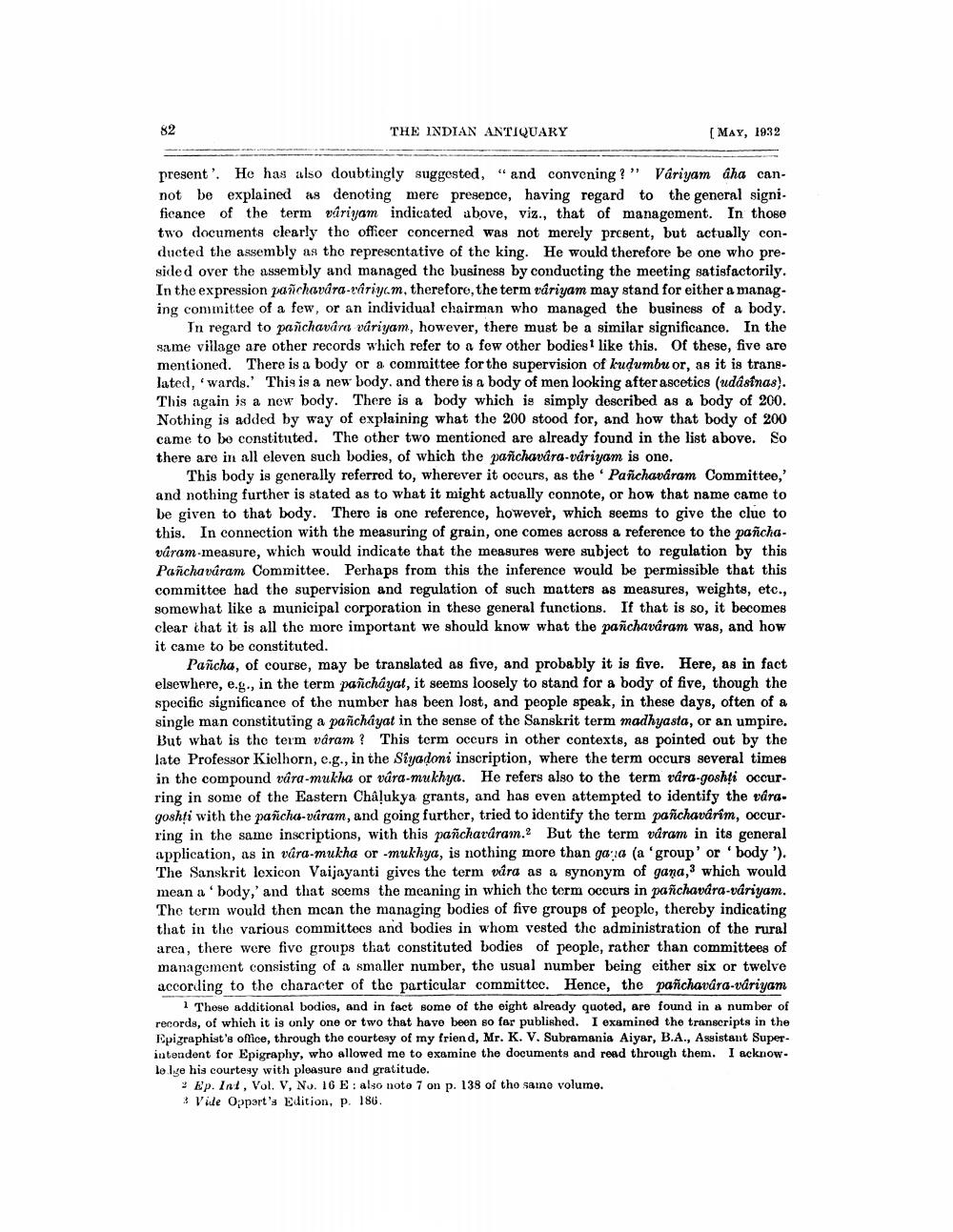________________
82
THE INDIAN ANTIQUARY
[ May, 1932
present'. He has also doubtingly suggested, “and convening ?" Variyam dha cannot be explained as denoting mere presence, having regard to the general signi. ficance of the term váriyam indicated above, viz., that of management. In those two documents clearly the officer concerned was not merely present, but actually conducted the assembly as the representative of the king. He would therefore be one who presided over the assembly and managed the business by conducting the meeting satisfactorily. In the expression pañchavára-râriyam, therefore, the term váriyam may stand for either a manag. ing committee of a few, or an individual chairman who managed the business of a body.
In regard to pañchavára váriyam, however, there must be a similar significance. In the same village are other records which refer to a few other bodies like this. Of these, five are mentioned. There is a body or a committee for the supervision of kudumbu or, as it is translated, 'wards. This is a new body and there is a body of men looking after ascetics (udásinas). This again is a new body. There is a body which is simply described as a body of 200. Nothing is added by way of explaining what the 200 stood for, and how that body of 200 came to be constituted. The other two mentioned are already found in the list above. So there are in all eleven such bodies, of which the panchavára-váriyam is one.
This body is generally referred to, wherever it occurs, as the Panchaváram Committee,' and nothing further is stated as to what it might actually connote, or how that name came to be given to that body. There is one reference, however, which seems to give the clue to this. In connection with the measuring of grain, one comes across a reference to the panchaváram-measure, which would indicate that the measures were subject to regulation by this Panchavúram Committee. Perhaps from this the inference would be permissible that this committee had the supervision and regulation of such matters as measures, weights, etc., somewhat like a municipal corporation in these general functions. If that is so, it becomes clear that it is all the more important we should know what the pañchaváram was, and how it came to be constituted.
Pancha, of course, may be translated as five, and probably it is five. Here, as in fact elsewhere, e.g., in the term panchayat, it seems loosely to stand for a body of five, though the specific significance of the number has been lost, and people speak, in these days, often of a single man constituting a panchayat in the sense of the Sanskrit term madhyasta, or an umpire. But what is the term váram? This term occurs in other contexts, as pointed out by the late Professor Kielhorn, e.g., in the Siyadoni inscription, where the term occurs several times in the compound våra-mukha or vára-mukhya. He refers also to the term vára-goshti occur. ring in some of the Eastern Châļukya grants, and has even attempted to identify the vara. goshti with the pañcha-viram, and going further, tried to identify the term pañchavárim, occur. ring in the same inscriptions, with this pañcharuram. But the term váram in its general application, as in vára-mukha or-mukhya, is nothing more than gaia (a 'group' or 'body'). The Sanskrit lexicon Vaijayanti gives the term vîra as a synonym of gana, which would mean a' body,' and that soems the meaning in which the term occurs in pañchavára-váriyam. The term would then mcan the managing bodies of five groups of people, thereby indicating that in the various committees and bodies in whom vested the administration of the rural area, there were five groups that constituted bodies of people, rather than committees of management consisting of a smaller number, the usual number being either six or twelve according to the character of the particular committee. Hence, the pañchavára-váriyan
1 These additional bodies, and in fact some of the eight already quoted, are found in a number of records, of which it is only one or two that have been so far published. I examined the transcripts in the Epigraphist's office, through the courtesy of my friend, Mr. K. V. Subramania Aiyar, B.A., Assistant Superintendent for Epigraphy, who allowed me to examine the documents and rond through them. I acknowle lye his courtesy with pleasure and gratitude.
Ep. In!, Vol. V, No. 16 E: also noto 7 on p. 138 of tho samo volume. 3 Vide Oppart's Edition, p. 186.




